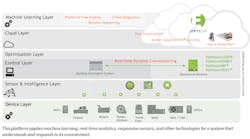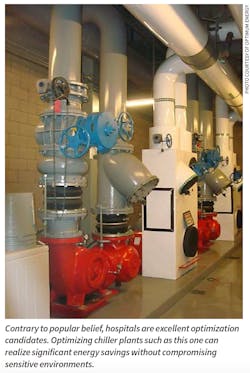Top 6 Myths About Optimizing Healthcare Facilities
By FREDERICK WOO, PE, Manager of Engineering, Optimum Energy
Healthcare facilities run full bore around the clock, and it shows in their operational costs.
Energy accounts for 51 percent of a typical hospital’s annual facilities budget, according to the American Society of Healthcare Engineering. Studies show that 30 to 40 percent of a healthcare facility’s total energy use can be chalked up to the HVAC system—the chilled water plant, the steam and hot water plant, and air distribution.
These factors add up to a strong case for HVAC optimization, which can cut a facility’s energy use and resulting costs by 20 to 50 percent, and reduce water use as well. However, myths about what HVAC optimization is and what it requires often make facilities managers hesitant to pursue it. Let’s clear those up.
Myth #1: A dashboard and fault detection provide optimization
REALITY: An energy dashboard and fault detection software provide only information. A true optimization solution automatically controls the facility’s HVAC system to deliver heating and cooling at the most energy-efficient levels. It takes a holistic approach to managing the system and all of its interactions, rather than addressing each piece of equipment in isolation. It also continuously measures system inputs (gas, electricity, and water) and outputs (heating, cooling, and air and water flows) so that it can dynamically adjust the system in real time.
Myth #2: A healthcare facility has too many restrictions to allow for optimization
REALITY: Healthcare facilities are complex environments that operate around the clock under strict constraints, but in many cases facilities are using far more energy than necessary to meet requirements. Optimization addresses that waste. Most facilities have dialed-in operational set points and procedures meant to fulfill worst-case conditioning and ventilation requirements. Often, systems operate at these set points at all times, even when they do not need to. An optimization solution can tune HVAC systems to run more efficiently while maintaining different temperatures for patient rooms, lab environments, surgery centers, and other sensitive environments.
Myth #3: A cloud-based optimization solution will compromise IT security
REALITY: Although new Internet connections can be risky, connecting a building automation system (BAS) to a secure cloud-based optimization solution is not. A cloud-based HVAC optimization solution collects real-time analytics and then runs diagnostics on the facility’s HVAC equipment in the solution provider’s data center. The connection can be protected with robust end-to-end security measures, including a platform that uses strong encryption and allows access only to energy-management data. With secure walls between the facility’s IT network and its BAS sensors and HVAC monitoring, hackers cannot use the optimization solution to access sensitive business or patient data.
Myth #4: HVAC optimization is too expensive
REALITY: Doing nothing to cut energy and water use is the most expensive path, especially in regions with high utility rates and at facilities operating under mandates to reduce their carbon footprint. An HVAC optimization project can deliver ROI in one to five years. Energy and water savings are immediate, as the system makes the chiller plant, air handlers, and boiler room operations more efficient as soon as it is switched on.
Myth #5: New, energy-efficient equipment doesn’t need optimization
REALITY: Even the most modern equipment is efficient only if it is programmed and controlled to save energy. For example, variable frequency drives (VFDs) installed on pumps and fans can either control equipment at constant set points or be programmed to run at full speed all the time. New variable speed chillers can be more efficient than constant speed chillers, but only if their loads and lifts are managed to take advantage of variable speed operations.
Myth #6: Automating an HVAC system eliminates operations staff
REALITY: HVAC optimization is a tool that enhances the work of facilities staff. It takes the guesswork out of running HVAC systems, and frees staff from making manual adjustments. Ultimately, refocusing employees on work that requires human intelligence improves overall facilities operations.
Healthcare facilities face the same challenges that compel every industry to consider HVAC optimization: rising energy costs due to increased use or higher rates, corporate commitments to saving energy and meeting sustainability goals, and the challenges of operating hodge-podge systems assembled over time. Because they also consume unusually high amounts of water and energy during 24- hour operation, hospitals are particularly ripe for an optimization solution that can curtail resource consumption, reduce costs, and improve operational efficiency.
Based in Seattle, the author is Manager of Engineering for Optimum Energy. A mechanical engineer with 15 years of experience in energy efficiency, HVAC controls, energy management systems, and Web-based data collection, he manages a team of 10 engineers who perform detailed assessments of public and commercial facility HVAC systems.


